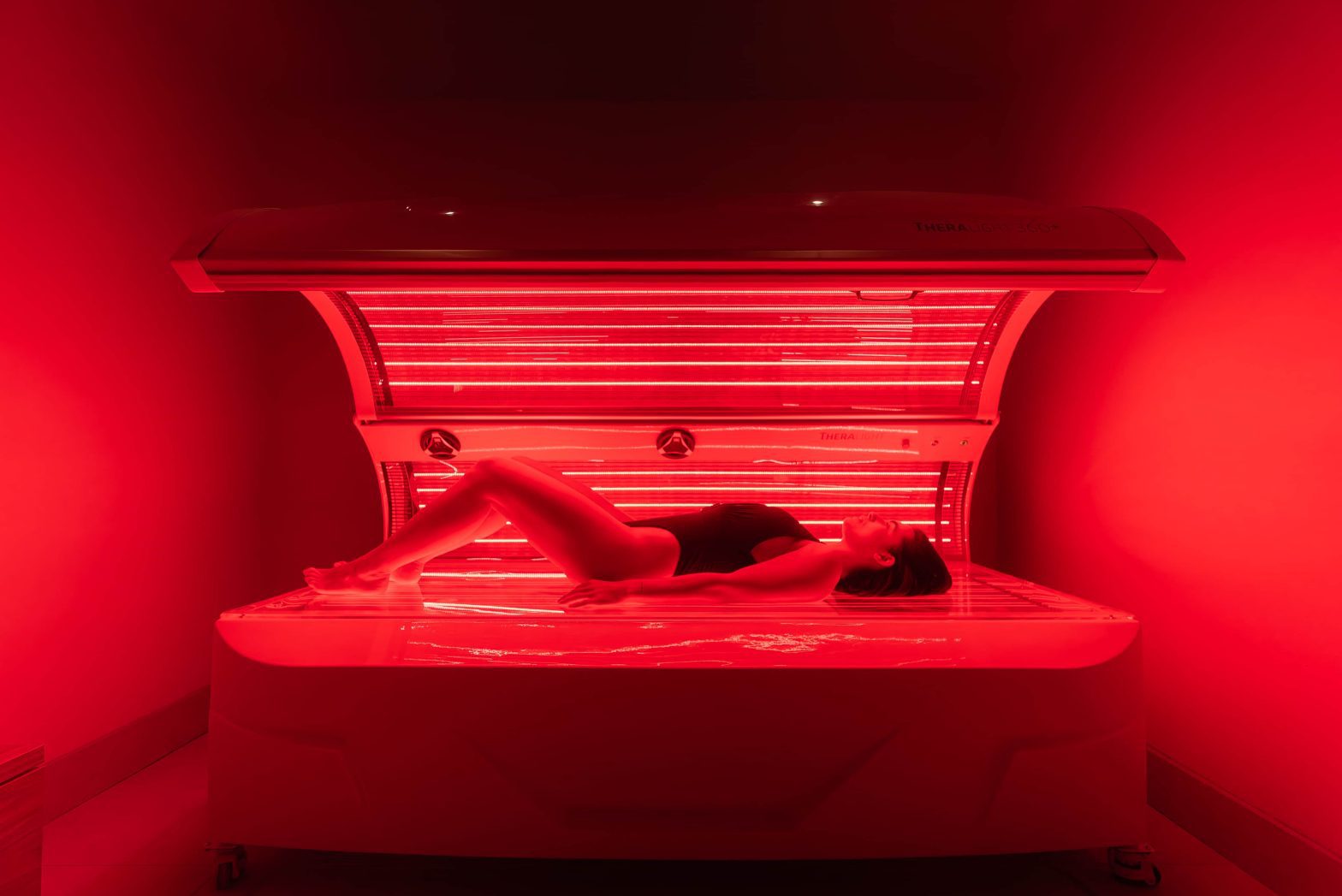With all of these promising benefits being discovered around red light therapy, it’s unsurprising that it could also be used to boost heart health.
Initial research suggests that red light therapy can have anti-inflammatory effects and better functional capacity in heart failure in rats. This strongly suggests phototherapy as a new therapy for heart disease and failure. While the majority of studies have been completed on mice, the findings show promise as a viable treatment for human health in the future.
What is red light therapy?
Red light therapy is a treatment that uses low-wavelength red light to improve a number of skin ailments. It has been proven to reduce wrinkles, scars, acne, and redness. It has also recently been indicated to help a number of other medical conditions.
There is currently plenty of ongoing research being conducted to test the effectiveness of red light therapy on these health conditions.
Red light therapy is also known by a number of different names, including:
- Low level laser therapy
- Non thermal LED light therapy
- Biostimulation or photonic stimulation
- Cold laser therapy
- Soft laser therapy
- Photobiomodulation
- Low power laser therapy
- Phototherapy
How does red light therapy work?
Red light therapy works by acting on the mitochondria of our bodies’ cells, which is otherwise known as the energy source. The more energy the mitochondria create, the more efficiently the cells can work. Cells have plenty of tasks to do around the body, such as repairing skin and boosting new cell growth. So, the more red light the cells can absorb, the better stimulated they can become to perform more effectively.
Most research has been focused on using red light therapy for skin benefits since the cells closest to the surface of your skin are most benefited by the RLT. However, initial findings of studies on mice have indicated that RLT might be able to affect the cells deeper within the body, too.
What are some of the potential heart health benefits of red light therapy?
Has the potential to improve heart functionality
Research has shown that exposure to red light therapy can improve the heart function of middle-aged mice. The same study indicated that red light therapy could mitigate the thickness of the cardiac wall, improving the pumping action of the heart to improve blood flow regulation. Mice and humans are very similar in a biological sense, so these findings are promising that similar results could be replicated in human heart health.
Can reduce inflammation
Red light therapy, when used in the correct way and dosage, can relieve pain and inflammation. Inflammation can promote the growth of plaques in your arteries and can trigger blood clots. Blood clots are one of the biggest causes of heart attacks and strokes, so using RLT to reduce inflammation can boost your heart’s health by preventing dangerous conditions.
Studies on mice have suggested that red light therapy has shown anti-inflammatory effects.
Might improve your sleep schedule
Red light therapy has been shown to improve sleep by increasing serum melatonin levels. A study showed that only 30 minutes of full-body red light therapy improved the sleep of a test group versus a placebo group. The American Heart Association features sleep on its list of key measures to improve and maintain heart health, so red light therapy might be able to indirectly benefit your heart health.
Scientific evidence and findings on the impact red light therapy has on heart health
There have been limited studies on the effectiveness of red light therapy specifically on heart health. However, one study published in 2021 set out to find the effects of red light therapy on the cardiac function of mice with heart failure.
The results on mice with heart failure that were exposed to red light therapy are as follows:
- The red light therapy showed anti-inflammatory effects, as well as better heart functionality.
- Thinning of the ventricular wall was reduced in the hearts of mice exposed to red light, indicating that the therapy slowed down the myocardial remodelling.
- Red light therapy could upregulate both calcium handling and cardiac function in single ventricular cardiomyocytes. As heart failure is characterised as the reduction of said cardiomyocytes, this suggests that RLT could be a viable treatment plan for heart failure.
This study was successful in showing the positive effects of red light therapy on cardiac function in mice with heart failure. This data can support further research into using red light therapy as a treatment for heart failure, but more research is needed to determine its effectiveness on human heart health.
Are there any potential risks or precautions to consider?
Red light therapy is generally considered safe, despite the fact that researchers haven’t completely figured out how RLT works yet. Thanks to this lack of definitive research, there are no hard or fast rules on how much light to use. It’s been indicated that too much red light might damage the skin tissue, but too little exposure might not benefit you.
Despite RLT units being considered healthy and safe, there have been minimal reports of burns, lesions, and blisters from light exposure. It’s suggested that the risk of these adverse effects increased after:
- Using RLT units for longer than 30 minutes at a time
- Falling asleep in the unit, increasing exposure until you wake up
- Using a faulty machine that might involve broken wires or corrosion
There is also a risk of eye damage when using red light therapy machines. An LED light source tends to be safer on the eyes than traditional lasers, but you should still wear the correct eye protection while exposing yourself to RLT.
How often should you consider using red light therapy for heart health benefits?
There is no research to indicate the best frequency of red light therapy to improve heart health yet, so it’s impossible for us to give you a definitive answer here. However, as there is currently no recommended limit to red light therapy exposure, most experts say that you can use this treatment up to seven days a week. Most recommend capping your use to four or five days a week, though.
You should prevent using red light therapy for longer than 30 minutes at a time, with most experts suggesting between 10 and 20 minutes being the sweet spot. Too much exposure at once can increase the risk of burns and legions, so don’t stay in the RLT unit for longer than half an hour at once.
Some believe the more exposure to red light therapy you can get, the better your chances are of reaping its benefits. However, it’s recommended that you talk to a healthcare professional before using red light therapy for heart health treatments.
Our in-house experts’ tips for using red light therapy to help with heart health
Tom Harvey, co-founder and co-director says:
- Consult your primary care physician before beginning treatment: Whether you have a pre-existing heart condition or you’re trying to prevent any from developing, it’s always advised that you talk to a professional to make sure this is the correct treatment plan for you
- Don’t exceed the recommended daily exposure: People have been injured after falling asleep in their red light therapy units and exposing themselves to too much RL, so make sure you don’t exceed the recommended dose of 30 minutes at a time
- Try to squeeze in as many sessions as you can per week: While there is a limit on how much exposure you should get per session, most experts agree that there’s no maximum limit to how many times you can frequent an RLT unit, so using this therapy multiple times a week can benefit you
- Consider the risks: There is a low risk of damaging your eyesight when using RLT machines, so make sure you’re using the correct protection before heading into your unit
- Use trusted machines and businesses: Faulty machines can increase the risk of burns and legions from the light, so it is imperative that you do your research and make sure that you know you’re using trusted, new equipment without faults
Final thoughts
Research on using red light therapy for heart health is limited, but a study conducted on mice with heart failure does show promising findings that RLT might be able to slow down the effects of heart failure and even improve the condition of the heart. More studies are needed to back these findings up, ideally using human participants rather than mice, but the initial research gives us hope that RLT could one day be a viable treatment for heart ailments.
Red light therapy is considered safe, but there are a few risks to be aware of. Always talk to your doctor before putting yourself on a new treatment plan such as red light therapy for improved heart health, as they will be able to advise you on whether this is a good treatment or preventative measure for you.




